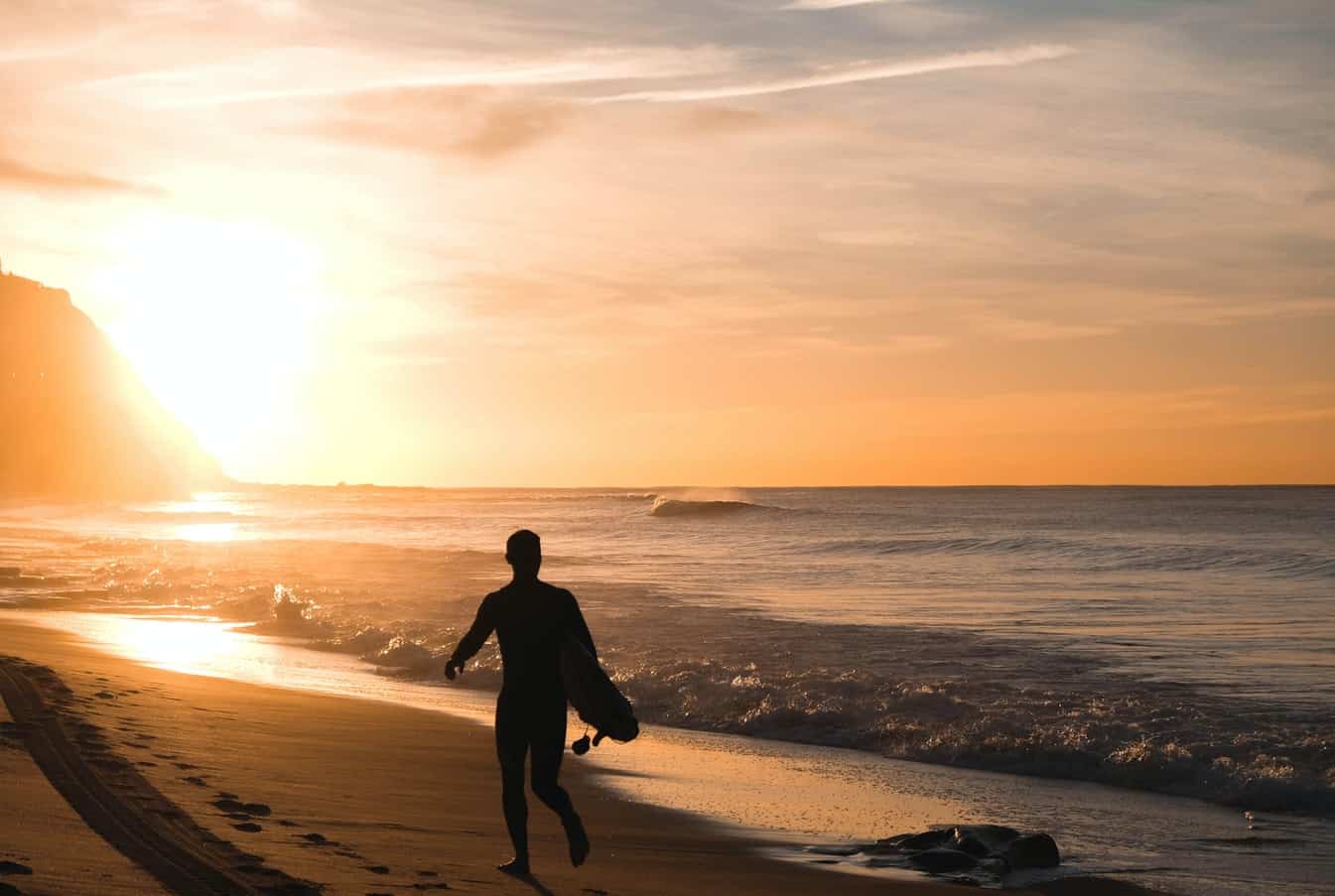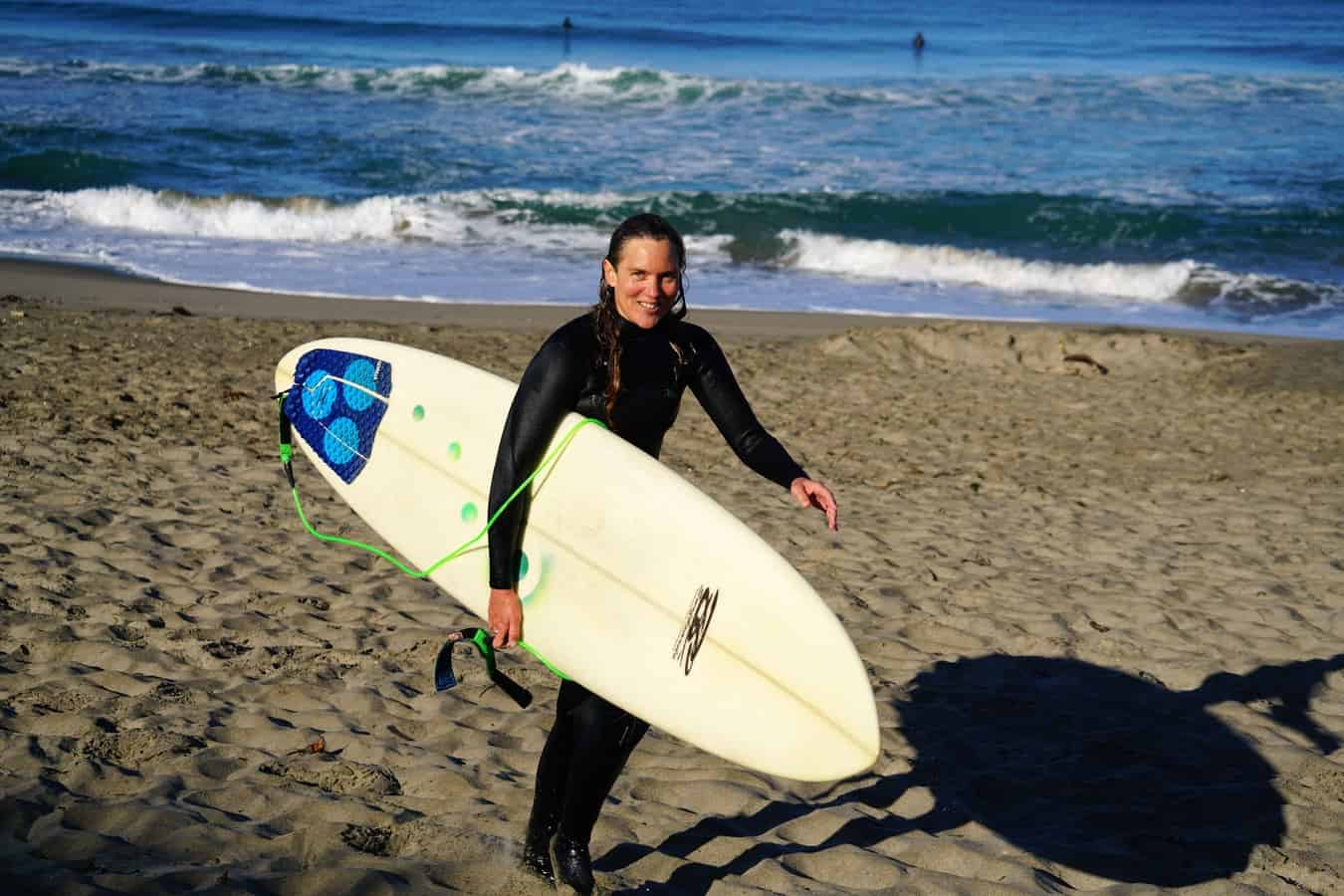Congratulations, you’re ready to learn to surf. Surfing is an ideal way to spend a day at the beach. Catching waves, enjoying the sun there’s nothing quite like it. It’s great exercise and a lot of fun.
But there’s plenty that goes into learning how to surf, how to read the waves, picking a board, working on balance, and definitely swimming. Swimming and surfing go hand in hand. In fact surfing requires some swimming in order to perform.
But how good do you actually have to be at it to surf? In order to surf, you need to have strong basic swim skills and be at least an intermediate swimmer. You don’t need to be a professional, but confident swimming is a must when it comes to surfing.
Surfing requires the ability to swim as these two skills are connected. To surf in the waves, you need a good grasp on floating, treading water and paddling.
The ocean has a mind of its own. Strong currents and waves can drag you from shore or pull you under. If you’re unable to swim, this can turn into a bad situation quickly.
If you plan to make surfing a habit, becoming a good swimmer is a must.
If you aren’t sure of your swimming ability, try the pool first or let your instructor know so they can help you determine if it’s safe for you to surf. You want to have the ability to tread water for a few minutes, swim to shore and hold your breath underwater.
Luckily, with practice you can become a better swimmer
Beginner Swimmers
The fastest way to get better at swimming is practice.
If you don’t know how to swim at all, or if you don’t feel comfortable swimming, hire a coach or join a group class, they’re available for every age group. Taking classes is the best way to learn to swim from scratch.
An instructor will be able to assess your current skill level and teach you from there. It’s also the safest option as you’ll have someone looking out for you while you learn.
If you know how to swim, but not that well, start out in a pool. You can find a pool at your local rec center or at the gym.
By removing the waves and current you find in the ocean, you’ll be able to focus solely on improving your swimming ability.
Swim laps to work on your stroke. This will also translate into helping you paddle when you get out on your board.
Dive for rings to practice controlling your breath. It will come in handy when you get tossed under a wave.
Practice treading water and floating on your back. These will help if you lose your board.
When you get out in the ocean, the water can be unpredictable so it’s important to have these basic skills down to keep you safe.
You won’t always have your board to keep you afloat and being sure you can swim will make a huge difference.
Intermediate to Advanced Swimmers
Once you feel confident in your basic skills, you can practice swimming in the ocean. Start out in the shallows where your feet can touch so you can get a feel for the water.
The ocean moves very differently from a pool or even a lake. The currents and waves add an extra challenge.
Learn to read the water so you know if a wave is coming and whether you’re caught in a rip tide. If you do get caught in a rip tide, swim parallel to the shore until you get out, then swim into the shore.
The best part of this step is you can practice swimming while you surf. In fact, once you’re confident in the ocean, the easiest way to continue to improve your swimming is by surfing.
Naturally as you continue to surf, your swimming ability will grow. But even the best swimmers should practice proper safety while surfing.
Don’t go out alone, make sure there’s a lifeguard on duty and don’t go out further than you can swim back. Again, don’t rely on your board to always get you to shore. You may wipe out, or your leash can break and you’ll need your arms and legs to swim back to land.
Tips For New Surfers
You know you need to be able to swim well, but what else does a new surfer need to know?
Lessons
Surfing isn’t really something you can learn all by yourself. You need someone to give you a rundown on how to do it.
Take some lessons if you’ve never surfed before. Not only is it safer to have a professional watching you, they’ll also help keep you from feeling discouraged while you learn a new skill.
Lessons will also help you learn faster. An instructor will go over all the basics of surfing with you. First on land to be sure you have it, then in the waves.
You’ll learn to paddle, pop up and how to read and catch waves. If you’re serious about learning to surf, lessons are the best place to start.

Board
Choosing your board is one of the biggest parts of surfing. Although shortboards look cool and are easier for tricks, don’t start out with one.
The general rule of thumb is, the longer the board the easier to balance. Longboards are also more buoyant making it easier to float.
In the beginning your balance will be shaky at best. Going for a longboard is definitely the best way to go.
Look for a soft top or foam board. Not only will this be better for all the time you’ll be spending laying down on your board, but they’re more resistant to damage.
As a new surfer your board will probably take some thrashings so it’s important to find one that’s durable. A foam board will also hurt less on the occasion you get hit by yours.
Gear
You might think all you need is your swimsuit, but there’s some other clothing you should consider.
Wear a wetsuit or rashguard. Depending on the temperature at your local beach, you’ll need a wetsuit. This will help keep you from freezing if the water is cold making your session a lot more enjoyable.
If you don’t need a wetsuit, definitely go for a rashguard. A rashguard is a shirt made of spandex and nylon or polyester.
Like the name says, it protects your skin from rashes. You’ll be spending a lot of time belly down on your board. Meaning your exposed skin will be rubbing against your board so wearing one will protect you.
Without a rashguard you’ll definitely end up with chafing.
Last, if your regular swimsuit leaves your legs fully exposed, you might want to try some boardshorts. In the same way a rashguard will protect your belly and chest, boardshorts will protect your thighs.
Sun Protection
Sunscreen deserves its own spot on this list. Due to the reflection on the water, the sun is more intense while surfing.
Add to this the hours you’ll likely spend in the waves and you’ll end up with a painful sunburn. Get an SPF of 30 or more. Look for water resistant and sport brands.
Apply 15-30 minutes before going in the water for best protection and make sure to apply often. Mineral or physical sunscreens are the best, but whatever you’re most likely to wear will be your best choice.
Stretching
It may seem obvious, but be sure to set aside time to warm up and cool down in your surf session.
A good stretch routine will help prepare your muscles for surfing. Without it you run the risk of pulling a muscle or otherwise hurting yourself.
Try dynamic stretches, active movements where joints and muscles go through a full range of motion. These will be the most helpful for the moves you’ll be doing while surfing.
You can even spend 10 minutes just swimming to get your muscles loose and warmed up.
Stretching afterwards is just as important as warming up. A cool down stretch helps your muscles in recovery.
Since you’re new to surfing, you’ll be using a lot of muscles you aren’t used to. By stretching afterwards, you’ll experience less soreness and achy stiff muscles, which is important for every surfer.
Etiquette
Surfing is a world all its own and it’s important to know some basic etiquette when you’re learning to surf. Having some general rules helps keep things safe and from tumbling into chaos out in the waves.
First, the surfer closest to the peak has the right of way, meaning it’s their wave.
Don’t drop in. This is when you try to ride a wave someone else is catching or already riding. Not only is it rude, but it can be dangerous and likely will cause a crash.
The general rule is one rider per wave. Although there can be certain caveats, you don’t need to worry about them in the beginning and abide by the one rider rule.
Share the waves and be respectful of other surfers by waiting your turn in the lineup.
Don’t throw or ditch your board if you can help it. A stray board is dangerous to other surfers, so stick with yours as best you can.
And, if you break any of the rules, communicate! An apology goes a long way when you realize you broke etiquette.
Related Questions
Can You Surf With a Life Jacket
Wearing a life jacket can be clunky and restrict your range of motion making it harder to surf well. That said, you definitely CAN wear a life vest if needed.
More and more companies are coming out with thinner or inflatable life jackets for triathletes and surfers.
Mostly big wave surfers use inflatable life vests. They can be crucial for when you’re in deep waters
Is Surfing Hard to Learn?
The difficulty of learning to surf depends entirely on the person. Some people pick it up quickly, while others may take months.
Once you stand up on a wave, you’re a surfer, although it will still take awhile to get good at it. Having good balance and swimming ability beforehand will help you learn to surf. As well as general physical fitness.
But people of all fitness levels can learn to surf. It all depends on your level of commitment and how much you practice.
In general it takes as little as one lesson to a couple months to learn to surf.

